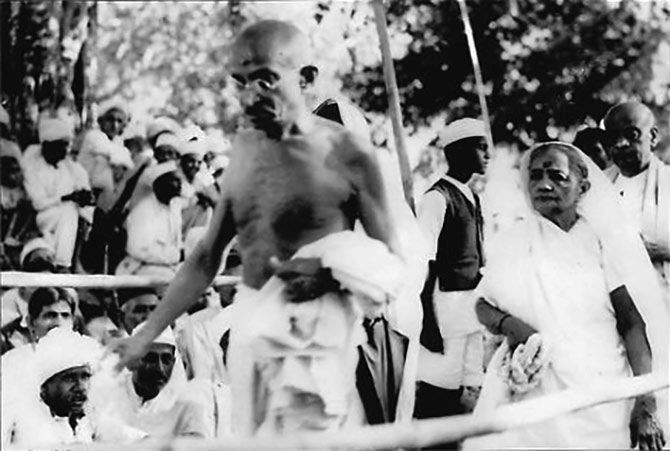Remembering Kasturba Gandhi, a silent symbol of sacrifice & service
Her life intertwined seamlessly with Mohandas’ relentless quest for truth, necessitating her acts of sacrifice and magnanimity

 In his autobiography My Experiments with Truth, Mahatma Gandhi tenderly reveals the enduring influence of his beloved wife, Kasturba, whose 155th birth anniversary is on April 11, 2024. She was six months older than her husband Mohandas Karamchand Gandhi. When she got married to Gandhi, she was 14.
In his autobiography My Experiments with Truth, Mahatma Gandhi tenderly reveals the enduring influence of his beloved wife, Kasturba, whose 155th birth anniversary is on April 11, 2024. She was six months older than her husband Mohandas Karamchand Gandhi. When she got married to Gandhi, she was 14.
In the autobiography, Mahatma Gandhi reflects on their intertwined journey, crediting Kasturba as his foremost teacher of non-violence. Her silent strength and gentle defiance shaped his understanding of Satyagraha from their early union, evolving into a pivotal figure in India’s freedom struggle. Evolving from a ‘devoted partner’ to a ‘Junior Partner’ in India’s freedom struggle, Kasturba epitomised resilience and dignity, leaving an indelible mark on history’s canvas.
In the captivating narrative penned by Louis Fischer in his biographical work, The Life of Mahatma Gandhi, he unveils a poignant portrayal of the early dynamics between Mahatma Gandhi and his wife, Kasturba. Within their union, marked by tender youthfulness, Gandhi’s assertion of marital authority clashes with Kasturba’s spirited independence. Despite his attempts at constraint, Kasturba emerges as a beacon of resilience, steadfastly asserting her autonomy amidst societal expectations.
Fischer’s account vividly illustrates the complexities of their relationship, a delicate balance between tradition and individual agency.
Gandhi’s philosophy reveres the resilience of women, epitomised by Kasturba’s unwavering commitment. He acknowledges women as transformative agents in the struggle for freedom, valuing their virtues of love, non-violence and self-sacrifice.
Embracing women as integral to societal change, Gandhi sees them embodying the essence of non-violence, their compassion and renunciation guiding the pursuit of justice. In his vision, women are essential architects of a better world, their strength and dedication are indispensable in shaping a more just and peaceful society.
In Dr Savita Singh’s reflections on Ba and Bapu, Gandhiji’s reverence for women echoes through his indebtedness to influential figures shaping his worldview. Singh writes, “Gandhi has acknowledged the debt of his mother, wife and the black women in South Africa and the Suffragette struggle of British women in 1906-07 as influences on the evolution of Satyagraha for which he is revered across the world. The attitude of respect and the world’s understanding of women’s problems that he exhibited later in life was derived from his mother and wife. This helped him perceive women as equal partners at home and in society and not merely as mothers and wives but as nation-builders too.”

Amidst the fervent currents of the Satyagraha movement on January 10, 1908, when Mohandas K. Gandhi along with 26 of his fellow Satyagrahis, all prominent in the boycott campaign in South Africa, against the Transvaal government’s discriminatory laws, voluntarily appeared in the court for sentencing and who were sentenced for two months’ imprisonment, Kasturba Gandhi emerged as a beacon of unwavering resolve. 0
Facing sentencing for their boycott campaign, Kasturba quietly pledged her devotion to Satyagraha. Moved by the plight of prisoners in South African jails, she resolved to endure the same hardships as her husband, subsisting solely on coarse and unflavoured cornmeal mush. Her sacrifice epitomised her profound commitment to justice and her solidarity with those engaged in the struggle.
As the matriarch of the Phoenix Settlement, Kasturba’s leadership was characterised by humility and determination. In Mohandas’ absence, she shouldered the responsibility of upholding his ideals and inspiring the community. Her innate dignity and unyielding self-belief garnered the respect, cooperation and affection of her peers. Leading not by decree but by example, she embodied the ethos of Satyagraha in her daily deeds.
Kasturba’s life intertwined seamlessly with Mohandas’ relentless quest for truth, necessitating her acts of sacrifice and magnanimity. She confronted every challenge with resolute determination, whether through patient conciliation or spirited defiance. In the face of injustice, such as the annulment of non-Christian marriages in South Africa, she heeded her husband’s call to action, galvanising other women to join the cause.
Amid adversity, Kasturba remained an unwavering pillar of strength. Her resilience was tested when she led a group of Indian women in protesting oppressive laws, despite her frail health. Supporting her comrades through the rigours of prison life, she inspired them with her enduring optimism and unwavering courage.
Mohandas Gandhi hailed the resolve of these women in his newspaper The Indian Opinion, praising their bravery in confronting government injustices and their invaluable contribution to the passive resistance campaign.
Back home, in the heart of Champaran, Bihar, where M K Gandhi pioneered his first Satyagraha, Kasturbai, as she was called, stood steadfastly by his side. Amidst the struggle against British oppression, she undertook a noble mission – educating village women on health, hygiene, and sanitation. With unwavering dedication, she traversed the district, igniting change. Through empowering women with vocational skills and instilling hygiene practices, she fostered a transformation.
As she bid farewell in 1918, Champaran blossomed with hope, cleansed of filth and filled with promise.
Further, in 1920, Kasturba, alongside Gandhi’s trusted lieutenant Maganlal Gandhi, started managing Sabarmati Ashram. Known as the ‘deity of the Ashrams’, Kasturba led 37 women in the historic Salt Satyagraha of 1930. Women, guided by Gandhiji, actively participated in protests like burning foreign clothes and picketing liquor shops. Kasturba also endured imprisonments in 1932 and 1939, embodying unwavering resilience and dedication to the cause.
It was in 1942 in the wake of the Quit India Movement that she was arrested for the last time. Before going to prison, Kasturba Gandhi called upon the women in particular to whom she said: “The women of India have to prove their mettle. They should all join in this struggle irrespective of caste or creed. Truth and non-violence must be our watchwords”.
In 1944, under house arrest at the Aga Khan Palace in Pune, Kasturba Gandhi breathed her last on February 22, 1944, with Gandhiji near her. An extraordinary life woven into such simplicity, Kasturba Gandhi was the epitome of women’s empowerment. But it was Mahatma Gandhi who in her Kasturbai, recognised the natural fervour for service for the good of all.
Arun Gandhi, the fifth grandson of Mahatma Gandhi from Manilal Gandhi – who was witness to the difficult, humiliating and often dangerous times under South Africa’s apartheid – says while quoting an unknown Eastern philosopher that “Nothing can ever grow under a Banyan tree” and refers to his grandfather Mohandas Karamchand Gandhi’s stature as more “Enormous than a Banyan tree”, so much so that “His stature dwarfed everyone else. Grandmother, Kastur and my father, Manilal, were two who submerged their identities and blended themselves into his image and philosophy”.
To conclude, Dr Savita Singh rightly says that “She (Kasturba) was the staff without whose support the metamorphosis of Mohandas Karamchand Gandhi into Mahatma would have remained an abortive endeavour. Hers was the silent but strong presence that helped him forge his unique, unconventional ammunition for the attainment of ‘Swaraj’ — both personal and political”.
Kasturba Gandhi was a symbol of empowerment and resilience, embodying the spirit of sacrifice and service.




